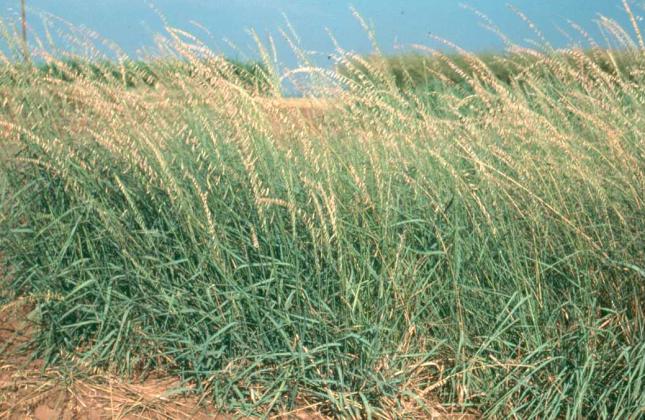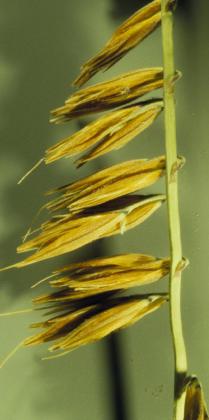Bouteloua curtipendula - State Grass of Texas
Bouteloua curtipendula, sideoats grama, is a perennial, warm-season, clump-forming grass found in most of North America. It is a Texas native, 8 to 36 inches tall with a jointed hollow stem. In the spring, when young, it is light bluegreen turning to shades of purple when mature. Leaves are about 1 foot long, ½ inch wide, alternate, light green to blue-green. Hairs grow from small, bulb-like spots on the edges. Basal leaves curl as they age turning brown or tan. Flower clusters, spike-like panicles or spikelets, are on one side of the stem. They bloom June through November turning purple-ish with deep-orange anthers and feathery white stigmas.
Sideoats grama has a dense, fibrous root system that allows it to survive droughts as well as flooding. It grows well and quickly in different soil types. Some years it produces two seed crops. The Texas Department of Transportation, txdot.gov, seeds sideoats grama along highways and on grasslands. It’s used for erosion control and restoring the land in burned areas. The grass supports wildlife habitats and rangelands that are important to cattle ranching, a major Texas industry. It is also used in landscapes.
The grass is called sideoats grama because its seeds resemble oats, Avena sativa, and hang on one side of the stem. The plant appears to be blowing in the wind. The word “grama” is often used to refer to pasture grasses. The genus is named for brothers Claudio (1774 1842) and Estéban (1776 - 1813) Boutelou, Spanish botanists. Curtipendula is from Latin. Curtus means “shortened” and pendulus means “hanging”.
As with other grasses, sideoats grama was used for brooms, bedding, thatched roofs, insulation, etc. For steam cooking, moist grass was laid on hot rocks. Some Native Americans used the spikelets instead of feathers as hair adornment and instead of a feathered lance. In some cases, each “feather” on the lance represented success against an enemy in battle. There is more information at the Native American Ethnobotany Database, naeb.brit.org.
In 1971 the Texas Legislature, capitol.texas.gov, acknowledged the usefulness of sideoats grama. The Texas Senate Concurrent Resolution No. 31, 62nd Legislature, Regular Session said, “... WHEREAS, Although there are many desirable forage species native to the State, one variety, sideoats grama, occurs on a greater diversity of soils than possibly any other grass... Sideoats grama produces a high quality, nutritious forage which is relished by all classes of livestock and wildlife; it is one of the State’s most attractive grasses as well, with its brilliant orange anthers and the purple inflorescence it produces upon maturity... RESOLVED, By the Senate of the State of Texas, the House of Representatives concurring, that sideoats grama [bouteloua curtipendula (Michx.) Torr.] be and it is hereby designated as the official State grass of Texas...”




